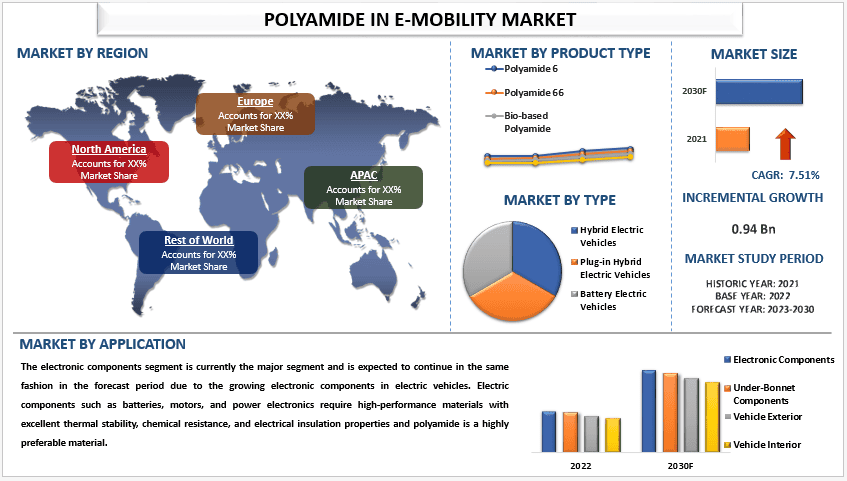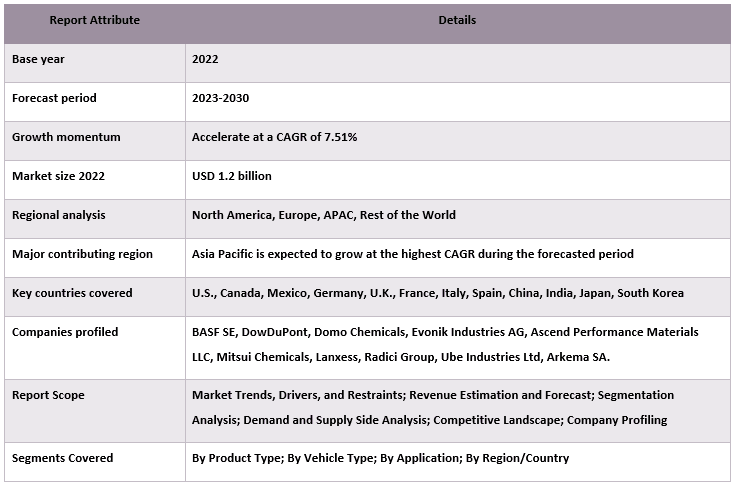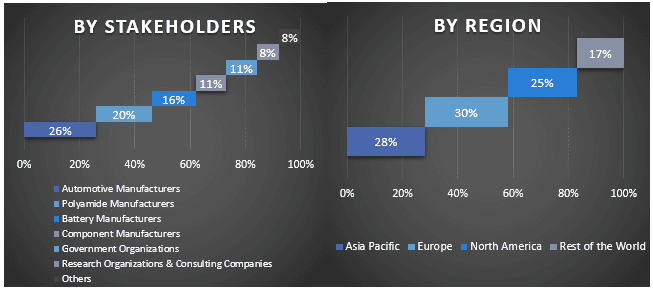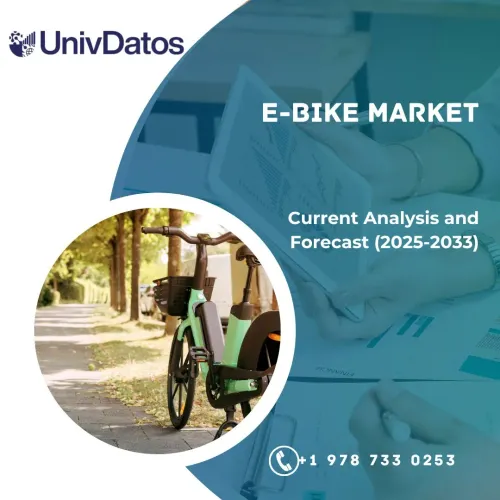- Home
- About Us
- Industry
- Services
- Reading
- Contact Us
Polyamide in E-mobility Market: Current Analysis and Forecast (2023-2030)
Emphasis on Product Type (Polyamide 6, Polyamide 66, Bio-based Polyamide, and Specialty Polyamides); Vehicle Type (Hybrid Electric Vehicles, Plug-in Hybrid Electric Vehicles, and Battery Electric Vehicles); Application (Electronic Components, Under-Bonnet Components, Vehicle Exterior, and Vehicle Interior); and Region/Country

The Polyamide in the E-mobility Market was valued at USD 1.2 Billion in 2022 and expected to grow at a CAGR of 7.51% during the forecast period from 2023-2030 to reach to 2.14 billion by 2030. Owing to the favorable government incentives and subsidies on sales of EVs. Government backing in the form of financial incentives and subsidies has been instrumental in steering the electrification of transportation, with a particular emphasis on electric vehicles (EVs). These initiatives have not only made EVs more affordable for purchasers but have additionally encouraged the improvement and deployment of advanced materials like polyamides, which are critical components in EV batteries, drivetrains, and other vital structures. The Chinese government has implemented a comprehensive plan to promote the adoption of New Energy Vehicles (NEVs), setting targets for both production and sales. To reach these goals, Beijing has introduced a range of incentives such as subsidies for EV purchases, investment in charging infrastructure, and tax breaks for producers. As a result, China has now become the world’s largest market for electric vehicles. Furthermore, in Europe, the European Union has established ambitious targets to reduce greenhouse gas emissions from transport, aiming for at least a 55% reduction by 2030 compared to 1990 levels. To facilitate this transition, the EU has introduced a variety of measures, consisting of the “Clean Vehicle Directive,” which mandates a minimum share of zero-emission automobiles (ZEVs) in member states’ new vehicle sales. For instance, in 2023, according to the report published by the US Department of Energy, The Clean Vehicle Rebate Project (CVRP) offers rebates to eligible state and local public entities for the purchase of qualified light-duty fleet vehicles from USD 3,500 to USD 7,000. Therefore, the ongoing favorable government incentives and subsidies drive polyamide in the E-mobility market.
Some of the major players operating in the market include BASF SE, DowDuPont, Domo Chemicals, Evonik Industries AG, Ascend Performance Materials LLC, Mitsui Chemicals, Lanxess, Radici Group, Ube Industries Ltd, Arkema SA. Several M&As along with partnerships have been undertaken by these players to facilitate customers with hi-tech and innovative products/technologies.
Insights Presented in the Report
“Amongst types, the polyamide 6 segment dominated the market in 2022”
Based on product type, the market is divided into polyamide 6, polyamide 66, bio-based polyamide, and specialty polyamides. The polyamide 6 dominated the market in 2022 and is expected to show the same trend in the forecast period. The primary motive for their dominance is their ability to be easily processed and molded into complex shapes and forms. This attribute makes it an appealing choice for manufacturers who necessitate intricate designs and exact dimensions in their products. Polyamide 6 gives a similarly substantial advantage in its eco-friendliness made from renewable resources such as castor oil and completely recyclable at the end of its provider life, PA6 is an attractive choice for corporations keen to lessen their environmental impact and follow sustainability rules. Moreover, given its biodegradability, polyamide 6 eliminates any need for highly priced disposal methods and reduces the likelihood of hazardous materials seeping into soil and water.
“Amongst vehicle type, the electric vehicle segment leading the market in 2022”
Based on vehicle type, the market is segmented into hybrid electric vehicles, plug-in hybrid electric vehicles, and battery electric vehicles. The electric vehicle segment is currently the leading segment and is expected to dominate the segment in the forecast period. Governments worldwide are implementing stringent regulations and incentives to encourage the adoption of eco-friendly transportation, which has spurred the demand for EVs. The prevalence of Electric Vehicle (EV) segments is additionally attributed to advancements in battery technology. The incorporation of lithium-ion batteries has significantly improved EV driving ranges and recharge times, making EVs a more competitive choice compared to traditional gasoline-powered vehicles. The utilization of polyamides in battery components such as separator films and electrode coatings has resulted in improved performance and safety of these batteries, leading to an increased demand for polyamides in the EV market.
Amongst applications, the electronic components segment is currently the major share in 2022.”
Based on application, the market is segmented into electronic components, under-bonnet components, vehicle exterior, and vehicle interior. The electronic components segment is currently the major segment and is expected to continue in the same fashion in the forecast period due to the growing electronic components in electric vehicles. Electric components such as batteries, motors, and power electronics require high-performance materials with excellent thermal stability, chemical resistance, and electrical insulation properties and polyamide is a highly preferable material. Moreover, the trend towards autonomous driving and connected cars calls for sophisticated electronic architectures that may process big amounts of data quickly and accurately. these systems depend heavily on superior sensors, actuators, and communication modules, all of which depend upon specialized polymers like polyamides for their proper functioning.
“Asia Pacific expedites highest CAGR for the polyamide in E-mobility market in 2022”
The Asia Pacific region has seen consistent growth in the automotive industry, with increasing electric car sales and production. This leads to a higher demand for polyamide service providers. Moreover, the presence of numerous domestic and international OEMs, suppliers, and startups in these countries creates a thriving ecosystem for the development and production of e-mobility technologies, further boosting the consumption of polyamides. Additionally, the Asia Pacific region is home to several of the most renowned technology hubs in the world, consisting of Silicon Valley, Tokyo, Seoul, and Bangalore, which promote innovation and research and improvement (R&D) activities in the field of e-mobility. This abundance of skills, information, and resources allows businesses to create revolutionary products and methods of production, in addition to strengthening the region’s popularity as a leader within the polyamide market for e-mobility.
Polyamide in E-mobility Market Report Coverage

Reasons to buy this report:
- The study includes market sizing and forecasting analysis validated by authenticated key industry experts.
- The report presents a quick review of overall industry performance at one glance.
- The report covers an in-depth analysis of prominent industry peers with a primary focus on key business financials, product portfolios, expansion strategies, and recent developments.
- Detailed examination of drivers, restraints, key trends, and opportunities prevailing in the industry.
- The study comprehensively covers the market across different segments.
- Deep dive regional level analysis of the industry.
Customization Options:
The global polyamide in E-mobility market can further be customized as per the requirement or any other market segment. Besides this, UMI understands that you may have your own business needs, hence feel free to contact us to get a report that completely suits your requirements.
Table of Content
Research Methodology for the Polyamide in E-mobility Market Analysis (2023-2030)
Analyzing the historical market, estimating the current market, and forecasting the future market of the global polyamide in E-mobility market were the three major steps undertaken to create and analyze the adoption of polyamide in E-mobility in major regions globally. Exhaustive secondary research was conducted to collect the historical market numbers and estimate the current market size. Secondly, to validate these insights, numerous findings and assumptions were taken into consideration. Moreover, exhaustive primary interviews were also conducted, with industry experts across the value chain of the global polyamide in E-mobility market. Post assumption and validation of market numbers through primary interviews, we employed a top-down/bottom-up approach to forecasting the complete market size. Thereafter, market breakdown and data triangulation methods were adopted to estimate and analyze the market size of segments and sub-segments of the industry pertains to. Detailed methodology is explained below:
Analysis of Historical Market Size
Step 1: In-Depth Study of Secondary Sources:
Detail secondary study was conducted to obtain the historical market size of the polyamide in E-mobility market through company internal sources such as annual reports & financial statements, performance presentations, press releases, etc., and external sources including journals, news & articles, government publications, competitor publications, sector reports, third-party database, and other credible publications.
Step 2: Market Segmentation:
After obtaining the historical market size of the polyamide in E-mobility market, we conducted a detailed secondary analysis to gather historical market insights and share for different segments & sub-segments for major regions. Major segments are included in the report as product type, vehicle type, and application. Further country-level analyses were conducted to evaluate the overall adoption of testing models in that region.
Step 3: Factor Analysis:
After acquiring the historical market size of different segments and sub-segments, we conducted a detailed factor analysis to estimate the current market size of the polyamide in E-mobility market. Further, we conducted factor analysis using dependent and independent variables such as product type, vehicle type, and application of the polyamide in the E-mobility market. A thorough analysis was conducted for demand and supply-side scenarios considering top partnerships, mergers and acquisitions, business expansion, and product launches in the polyamide E-mobility market sector across the globe.
Current Market Size Estimate & Forecast
Current Market Sizing: Based on actionable insights from the above 3 steps, we arrived at the current market size, key players in the global polyamide in E-mobility market, and market shares of the segments. All the required percentage shares split and market breakdowns were determined using the above-mentioned secondary approach and were verified through primary interviews.
Estimation & Forecasting: For market estimation and forecast, weights were assigned to different factors including drivers & trends, restraints, and opportunities available for the stakeholders. After analyzing these factors, relevant forecasting techniques i.e., the top-down/bottom-up approach were applied to arrive at the market forecast for 2030 for different segments and sub-segments across the major markets globally. The research methodology adopted to estimate the market size encompasses:
- The industry’s market size, in terms of revenue (USD) and the adoption rate of the polyamide in E-mobility market across the major markets domestically
- All percentage shares, splits, and breakdowns of market segments and sub-segments
- Key players in the global polyamide E-mobility market in terms of products offered. Also, the growth strategies adopted by these players to compete in the fast-growing market
Market Size and Share Validation
Primary Research: In-depth interviews were conducted with the Key Opinion Leaders (KOLs) including Top Level Executives (CXO/VPs, Sales Head, Marketing Head, Operational Head, Regional Head, Country Head, etc.) across major regions. Primary research findings were then summarized, and statistical analysis was performed to prove the stated hypothesis. Inputs from primary research were consolidated with secondary findings, hence turning information into actionable insights.
Split of Primary Participants in Different Regions

Market Engineering
The data triangulation technique was employed to complete the overall market estimation and to arrive at precise statistical numbers for each segment and sub-segment of the global polyamide in E-mobility market. Data was split into several segments & sub-segments post studying various parameters and trends in the areas of the product type, vehicle type, and application in the global polyamide in E-mobility market.
The main objective of the Global Storage Tank Market Study
The current & future market trends of the global polyamide in E-mobility market were pinpointed in the study. Investors can gain strategic insights to base their discretion for investments on the qualitative and quantitative analysis performed in the study. Current and future market trends determined the overall attractiveness of the market at a regional level, providing a platform for the industrial participant to exploit the untapped market to benefit from a first-mover advantage. Other quantitative goals of the studies include:
- Analyze the current and forecast market size of the polyamide in E-mobility market in terms of value (USD). Also, analyze the current and forecast market size of different segments and sub-segments
- Segments in the study include areas of the product type, vehicle type, and application
- Define and analysis of the regulatory framework for the polyamide in E-mobility industry
- Analyze the value chain involved with the presence of various intermediaries, along with analyzing customer and competitor behaviors of the industry
- Analyze the current and forecast market size of the polyamide in E-mobility market for the major region
- Major countries of regions studied in the report include Asia Pacific, Europe, North America, and the Rest of the World
- Company profiles of the polyamide in E-mobility market and the growth strategies adopted by the market players to sustain in the fast-growing market
- Deep dive regional level analysis of the industry
Related Reports
Customers who bought this item also bought










